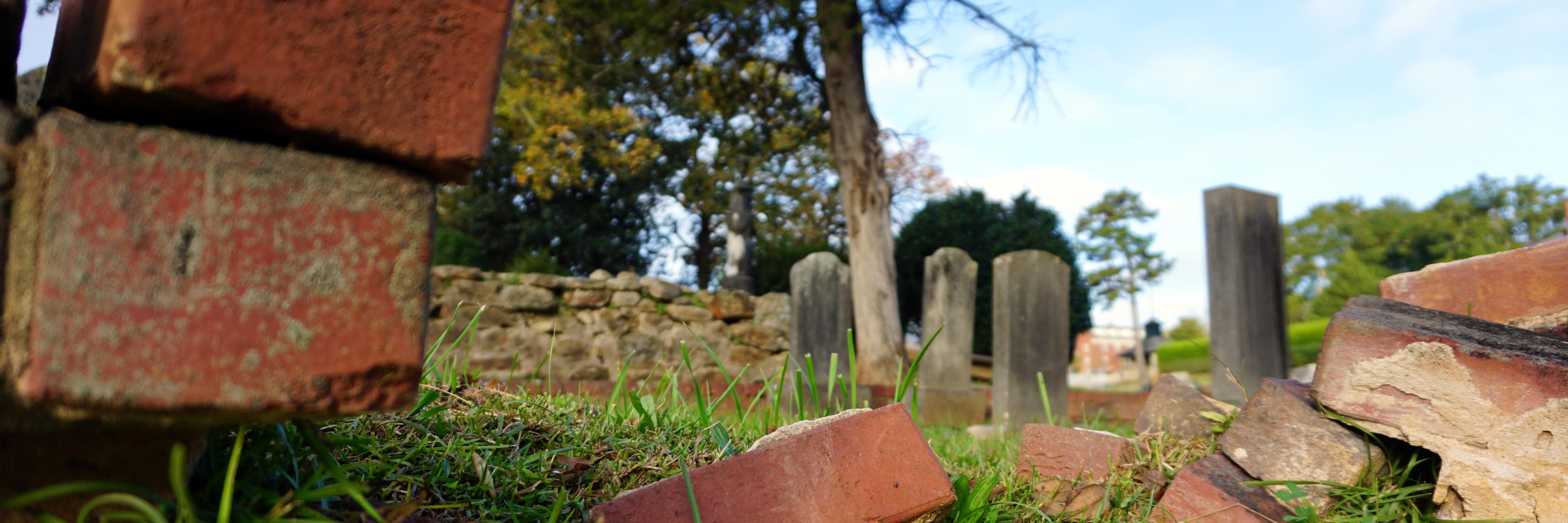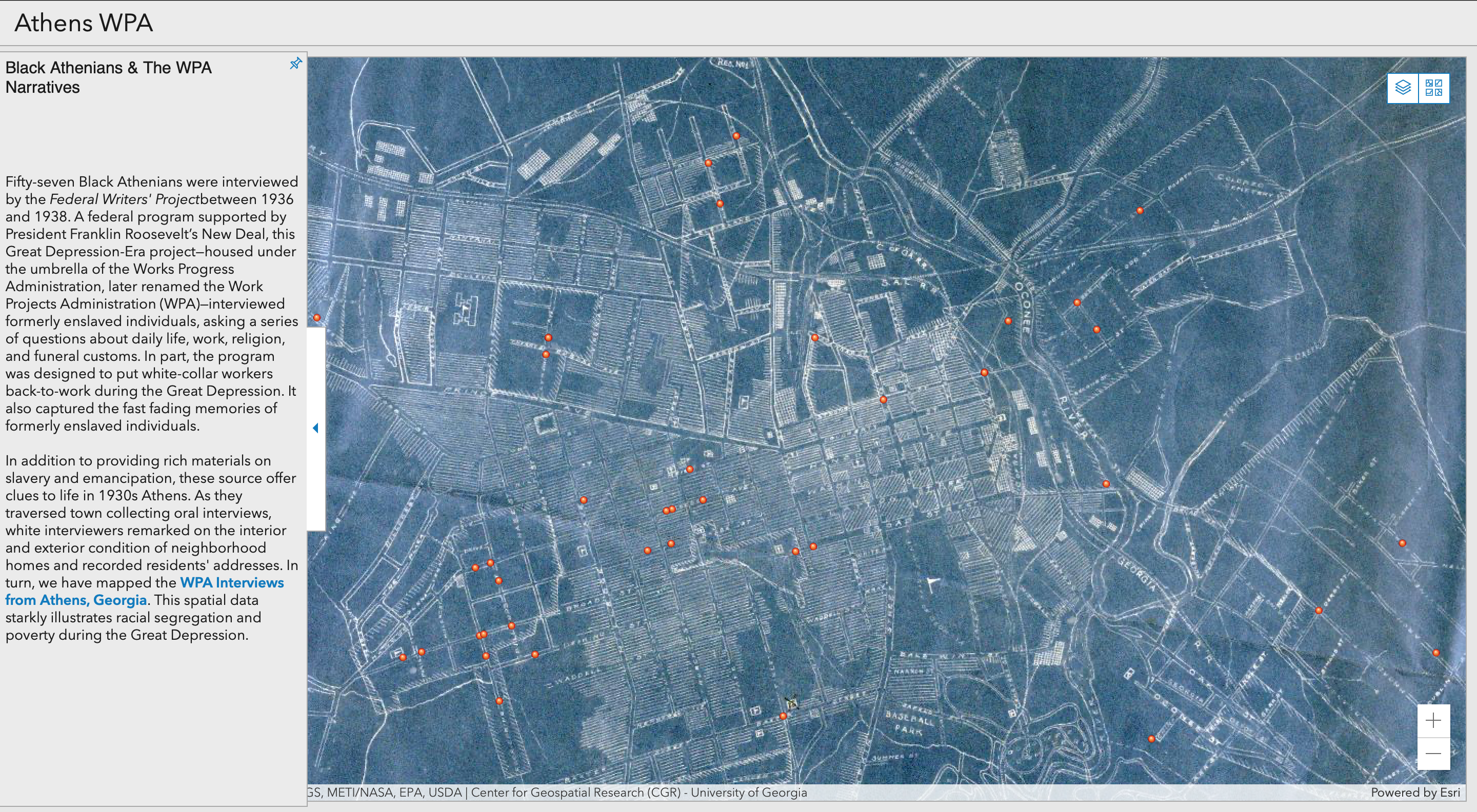Black Athenians & the WPA Narratives
Fifty-seven Black Athenians were interviewed by the Federal Writers' Project between 1936 and 1938. A federal program supported by President Franklin Roosevelt’s New Deal, this Great Depression-Era project—housed under the umbrella of the Works Progress Administration, later renamed the Work Projects Administration (WPA)—interviewed formerly enslaved individuals, asking a series of questions about daily life, work, religion, and funeral customs. In part, the program was designed to put white-collar workers back-to-work during the Great Depression. It also captured the fast fading memories of formerly enslaved individuals. Born during the 1850s and 1860s, these Black men and women—mostly in their 70s and 80s when interviewed—reminisced about their early lives and recalled the horrors of slavery and Jim Crow Era violence. The plantation mistress “used to punch" Georgia Smith, an enslaved child, "when she wannid someping in de night, an' effen I was hard to wake, she she' could punch wid dat stick.” [1] Ike Derricotte remembered the disease that came in the wake of war: “Dem Yankees brought de smallpox here wid 'em and give it to all de Athens folks, and dat was somepin awful. Folks jus' died out wid it so bad.” [2] During Reconstruction, the Ku Klux Klan instilled a pervasive sense of fear and helplessness in the Black community; the memories of such intensive emotional experiences lingered well into old age. “Dem night riders done plenty of whuppin' on our plantation,” remarked Tom Hawkins. “I 'members de Klu Klux Klan good," said John Hill, "Dey kept Niggers skeered plum to death, an' when dey done sumpin' brash dey sho' got beat up if de Kluxers cotched 'em.” [3]
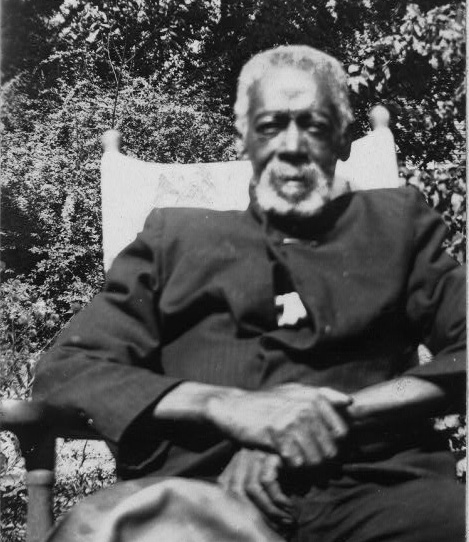
Yet, these sources are not without flaws. [4] First, the sample size was small; only around 2,300 interviews were conducted. Likewise, participants were asked to reflect upon events occurring at least seventy years ago. Most interviewees experienced slavery only as young children, with emancipation occurring when they were under ten years old. And those who had been enslaved as adults were, at the time of these interviews, upwards of ninety years old; memory, critics argue, fades and grows rosy over time. Frances Willingham’s daughter remarked, "Ma, now don't you git started 'bout dem old times. You knows your mind ain't no good no more. Tomorrow your tongue will be runnin' lak a bell clapper a-talkin' to yourself."[5]
White interviewers, moreover, had clear racial prejudice, some more pronounced than others. Mrs. Sadie Hornsby, an white interviewer based in Athens, often remarked about individuals’ skin tones and the cleanliness of their homes. Hornsby described Dosia Harris as “tall, thin, and a little stooped. . . [with] wooly hair.” The white interviewer noted: “Due to illiteracy Dosia has retained the dialect of the old southern darky.” [6] Hornsby appeared surprised when a home was well-kept or a Black woman well-dressed. Aside from her editorializing, little is known about Hornsby. She was a white woman who, from 1935 to 1940, rented a home on Prince Avenue across the street from several Black families. She may or may not have known her neighbors. [7]
Black interviewees, likewise, had good reason to be cautious and guarded in the presence of an inquisitive white man or woman. As eminent historian John W. Blassingame noted, “the black man’s vulnerability to white oppression was painfully evident in the Depression South. From 1931 to 1935, for example, there were more than seventy lynching in the South; nine blacks who had committed no crimes were killed, and twenty-five were lynched for minor offenses. Many black informants lived in areas were labor contracts were negotiated in jails, debt was perpetual, travel was restricted, and the threat of violence made peonage a living hell.” In short, Blassingame concludes, “the answers to many of the questions on the WPA interview schedule could neither be divorced from the dependent position of the aged blacks nor the contemporary state of race relations in the South.” [8] Black communities were vulnerable and exploited all across America and especially in the Deep South. Within such context, questions—“Was your master kind?” or “Is freedom or slavery better?”—could be, and at times were, menacing. In turn, some respondents carefully considered their answers. Not all, however, spoke with such guarded restraint. Easter Brown directly addressed instances of abuse and cruelty, even when speaking with a white interviewer. “Mist'ess was good to me . . . , but Marster was real cruel. He'd beat his hoss down on his knees and he kilt one of 'em. He whupped de Niggers when dey didn't do right,” she remembered. [9]
Centering the Black experience, interviewees reflected on daily life--the good times and the bad times. Even in old age, Minnie Davis clearly remembered Emancipation Day in Athens, and the sense of possibility and optimistic jubilation that accompanied the celebration. “On the day we learned of the surrender, the Negroes rallied around the liberty flag pole that they set up near where the city hall is now.” Raising their voices in song, they proclaimed, “'We rally around the flag pole of liberty, The Union forever, Hurrah! Boys Hurrah!'” Whites chopped down flag pole the next day. [10] Others recalled their youthful school days at Knox Institute. Eight-year-old Georgia Telfair "had to walk from Epps Bridge Road to Knox School . . . I toted my blue back speller in one han' and my dinner bucket in de other." [11] Another pupil, Susan McIntosh, "went to school there about three months, then Ma took sick, and I didn't go no more." [12] Slavery, emancipation, school, family life, ect.--these are just some of the many subjects examined in the WPA Slave Narrative Collection. As a valuable lens into the Black community, these sources offer a rich analysis of life and, even death, in Athens, Georgia.
Mapping
In addition to providing rich materials on slavery and emancipation, these source offer clues to life in 1930s Athens. As they traversed town collecting oral interviews, white interviewers remarked on the interior and exterior condition of neighborhood homes and recorded residents' addresses. In turn, we have mapped the WPA Interviews from Athens, Georgia. This spatial data starkly illustrates racial segregation and poverty during the Great Depression. To view the interactive map, click here.
WPA Interviews
The Federal Writers' Project interviewed fifty-seven Black Athenians. These accounts of slavery, segregation, and freedom show the resiliency and humanity of these formerly held in bondage. Not all were enslaved in Athens, in Clarke County, or even in Georgia. Some folks arrived in Athens in the Civil War's wake; others moved here later in life for employment opportunities or for personal reasons. And still others were born nearby, moved North, and only recently returned in their hometown. Regardless of when or why they arrived, each of these elderly men and women resided in Athens during the 1930s. As a companion to the spatial visualization above, we have included interview transcriptions below. The full collection--with interviews from all southern states--is available online at the Library of Congress.
Adams, Rachel --> 300 Odd Street
Baker, Georgia --> 369 Meigs Street
Battle, Jasper --> 112 Berry Street
Bolton, James --> Athens, Georgia
Bradley, Alice --> Athens, Georgia
Brown, Easter --> 1020 S. Lumpkin Street
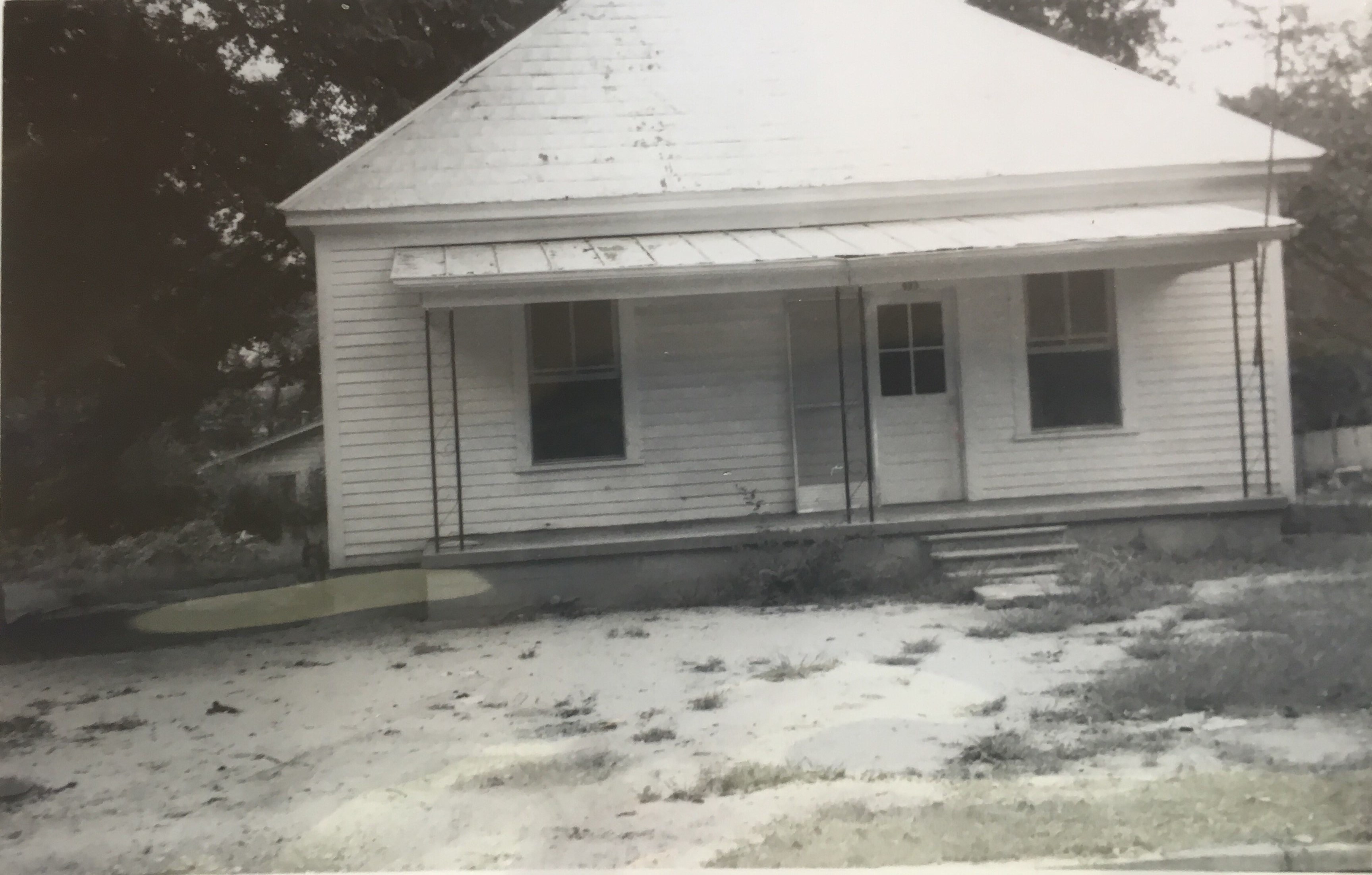
Castle, Susan --> 1257 W Hancock Avenue
Cofer, Willis --> 548 Findley Street
Colbert, Mary --> 168 Pearl Street
Cole, John --> Billups Street
Cole, Julia --> 169 Yonah Avenue
Colquitt, Kizzie --> 243 Macon Avenue
Colquitt, Martha --> 190 Lyndon Avenue
Davis, Minnie --> 237 Billups Street (Buried in Gospel Pilgrim Cemetery)
Derricotte, Ike --> 554 Hancock Avenue
Dillard, Benny --> Cor. Broad and Derby Streets
Elder, Callie --> 640 W. Hancock Avenue
Furr, Anderson --> 298 W. Broad Street
Garey, Elisha Doc --> 258 Lyndon Avenue
Green, Alice --> 156 Willow Street
Harris, Dosia --> 159 Valley Street
Hawkins, Tom --> 163 Bremen Street
Heard, Bill --> 475 Reese Street (Buried in Gospel Pilgrim Cemetery)
Henry, Jefferson Franklin --> Athens, Georgia
Henry, Robert --> Athens, Georgia
Hill, John --> 1525 Broad Street
Hudson, Carrie --> 258 Lyndon Avenue (Likely Buried in Gospel Pilgrim Cemetery)
Hudson, Charlie --> 258 Lyndon Avenue (Buried in Gospel Pilgrim Cemetery)
Huff, Easter --> 125 Rockspring Street
Hunter, Lina --> 270 Bailey Street
Hutchesom, Alice --> 165 Rockspring Street
Jewel, Mahala --> 177 Berry Street
Johnson, Georgia --> 1537 W. Broad Street
Kinney, Nicey --> R.F.D. # 3 Athens, Georgia
Larken, Julia --> 693 Meigs Street
McCommons, Mirriam --> 164 Augusta Avenue
McCree, Ed --> 543 Reese Street (Buried in Gospel Pilgrim Cemetery)
McCullough, Lucy --> Athens, Georgia
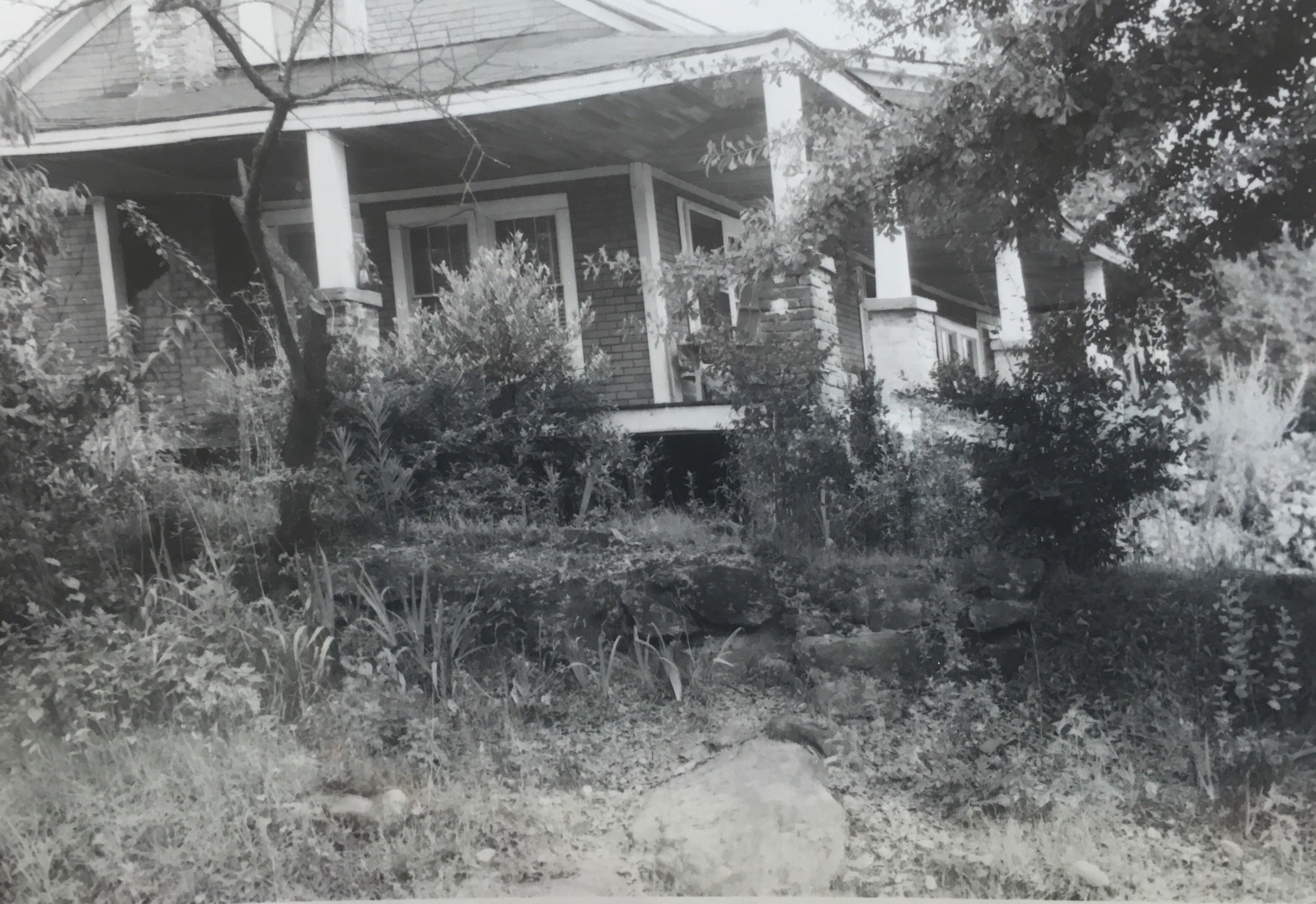
McIntosh, Susan --> 1203 W. Hancock Avenue (Buried in Gospel Pilgrim Cemetery)
McWhorter, William --> 383 W. Broad Street
Parkes, Anna --> 150 Strong Street
Pope, Alec --> 1345 Rockspring Street
Sheets, Will --> 1290 W. Broad Street
Shepherd, Robert --> 386 Arch Street
Singleton, Tom --> "Brooklyn section of Athens"
Smith, Georgia --> 286 Augusta Avenue (Buried in Gospel Pilgrim Cemetery)
Smith, Nancy --> 129 Plum Street
Smith, Nellie --> 660 W. Hancock Avenue
Smith, Paul --> 429 China Street
Telfair, Georgia --> R.F.D. # 2 Athens, Georgia
Thomas, Cordelia --> 130 Berry Street (Buried in Gospel Pilgrim Cemetery)
Upson, Neal --> 450 4th Street (Buried in Gospel Pilgrim Cemetery)
Van Hook, John F. --> Newton Bridge Road
Vinson, Addie --> 653 Dearing Street
Virgel, Emma --> 1491 W. Broad Street (Buried in Gospel Pilgrim Cemetery)
Willbanks, Green --> 347 Fairview Street
Willingham, Frances --> 288 Bridge Street
NEXT: WPA Life Histories
[1] Georgia Smith, Federal Writers' Project: Slave Narrative Project, Vol. 4, Part 3, Kendricks-Styles (1936), Library of Congress, Manuscript/Mixed Material. https://www.loc.gov/item/mesn043/
[2] Ike Derricotte, Federal Writers' Project: Slave Narrative Project, Vol. 4, Georgia, Part 1, Adams-Furr (1936), Library of Congress, Manuscript/Mixed Material. https://www.loc.gov/item/mesn041/.
[3] Tom Hawkins, Federal Writers' Project: Slave Narrative Project, Vol. 4, Part 2, Garey-Jones (1936), Library of Congress, Manuscript/Mixed Material. https://www.loc.gov/item/mesn042/; John Hill, Federal Writers' Project: Slave Narrative Project, Vol. 4, Part 2, Garey-Jones (1936), Library of Congress, Manuscript/Mixed Material. https://www.loc.gov/item/mesn042/
[4] Those seeking to learn more about the WPA interviews as historical sources may wish to consult the following works: John W. Blassingame, “Using the Testimony of Ex-Slaves: Approaches and Problems, The Journal of Southern History, Vol. 41, No. 4 (Nov., 1975): 473-492; Stephanie J. Shaw, “Using the WPA Ex-Slave Narratives to Study the Impact of the Great Depression,” The Journal of Southern History, Vol. 69, No. 3 (Aug., 2003): 623-658; Paul D. Escott, “The Art and Science of Reading WPA Slave Narratives,” in Charles T. Davis and Henry Louis Gates Jr., eds. The Slave's Narrative (New York: Oxford University Press, 1991).
[5] Frances Willingham, Federal Writers' Project: Slave Narrative Project, Vol. 4, Part 4, Telfair-Young (1936), Library of Congress, Manuscript/Mixed Material. http://hdl.loc.gov/loc.mss/mesn.044
[6] Dosia Harris, Federal Writers' Project: Slave Narrative Project, Vol. 4, Part 2, Garey-Jones (1936), Library of Congress, Manuscript/Mixed Material. https://www.loc.gov/item/mesn042/
[7] H. Michael Gelfand, “Chronicling an African-American Life in Athens: James W. Davis and His Georgia Writers' Project Interview, 1939,” The Georgia Historical Quarterly,Vol. 81, No. 3 (Fall 1997), 714-715.
[8] Blassingame, “Using the Testimony of Ex-Slaves,” 482.
[9] Easter Brown, Federal Writers' Project: Slave Narrative Project, Vol. 4, Georgia, Part 1, Adams-Furr (1936), Library of Congress, Manuscript/Mixed Material.
[10] Minnie Davis, Federal Writers' Project: Slave Narrative Project, Vol. 4, Georgia, Part 1, Adams-Furr (1936), Library of Congress, Manuscript/Mixed Material. https://www.loc.gov/item/mesn041/.
[11] Georgia Telfair, Federal Writers' Project: Slave Narrative Project, Vol. 4, Part 4, Telfair-Young (1936), Library of Congress, Manuscript/Mixed Material. http://hdl.loc.gov/loc.mss/mesn.044
[12] Susan McIntosh, Federal Writers' Project: Slave Narrative Project, Vol. 4, Part 3, Kendricks-Styles (1936), Library of Congress, Manuscript/Mixed Material. https://www.loc.gov/item/mesn043/

